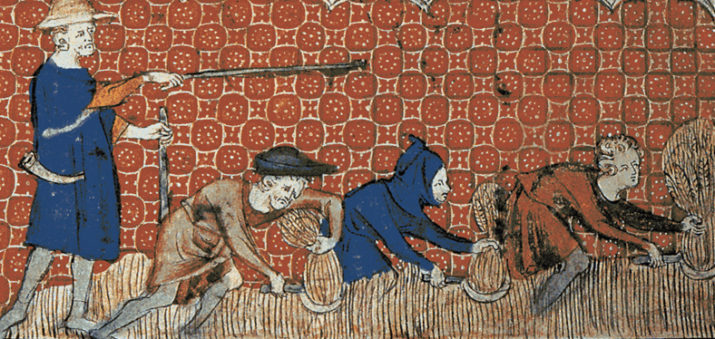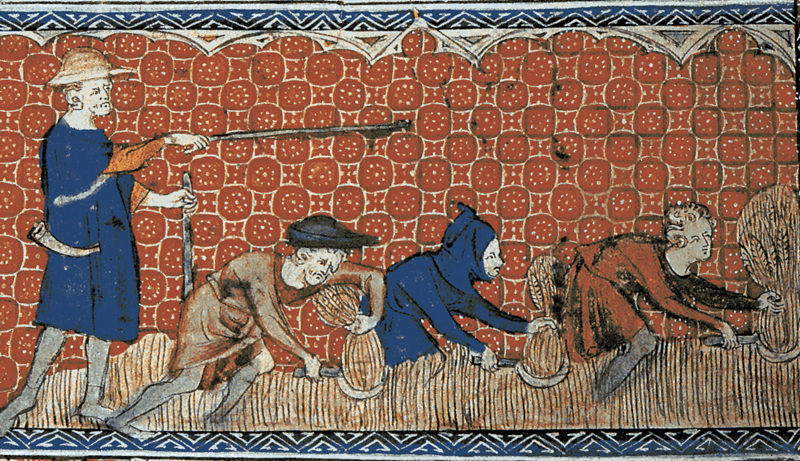

This is part of our special feature on Food, Food Systems, and Agriculture.
Famines and lesser dearths were frequent threats to medieval English society, especially in the century and a half before the mid-fourteenth century crisis of the Black Death, and during a period when population grew to such an extent that it outstripped society’s capacity to feed itself. A combination of narrative accounts of famine, and a more general mapping of harvests through yield and price data, indicates that twenty-three of the 140 years between 1210 and 1350 experienced poor harvests in one or more grains, and approximately half of these were sufficiently extreme and their consequences sufficiently severe to be counted as crisis events (Dyer 1989: 262-3; Hoyle 2017: 148). While we have a general sense of famine events in this period and some inroads into exploring the extent and impact of famine and dearth, there is also a great deal we do not know about famine in the middle ages. In fact, our ignorance in regards to famine reflects a more general gap in our understanding of medieval society. In particular, we know more about a small percentage of elites at the very top of medieval society than we do about the bulk of society, and we know little about the poorest 40 percent or so—in other words, those most likely to be vulnerable to famine events. Despite this, we can still say quite a lot about aspects of life amongst the medieval peasantry and we can gain some useful insight into some features of their response to famine and similar crisis events. However, we can say little about the everyday experience of the poorest – and by extension the most famine-vulnerable – members of society, and that poses something of a problem for historians of medieval famine.
In medieval society, commentators, chroniclers, and annalists, were both aware of famine and prepared to report it as part of their year-by-year narrative of key events. While matters of the state and its leaders tended to dominate such narratives, an often fairly formulaic description of famines and dearths appears from time to time in the chronicles. Some of the key ingredients of famine – poor weather, failed harvests, and subsequent disruption, including high prices and deaths – are often identified in such accounts, as this example from the early fourteenth-century Life of Edward II illustrates:
Such a scarcity has not been seen in our time in England, nor heard for a hundred years. For the measure of wheat was sold in London and the neighbouring places for 40d., and in other less thickly populated parts of the country 30d. was a common price. Indeed during this time of scarcity a great famine appeared, and after the famine came a severe pestilence, of which many thousands died in different places (Childs 2005: 120).
On rare occasions, English chroniclers described famine events in greater depth and with the occasional lurid detail; this is especially the case with the chronicle of John de Trokelowe, a monk of St Albans Abbey, who describes the severe conditions of the Great Famine of the early fourteenth century. He paints a vivid picture of starvation, disease, and societal breakdown, including hints of cannibalism. While most historians would now consider medieval references to cannibalism as deliberate hyperbole, with some Biblical allusion, intended to emphasise the severity of the event, there is no doubt that famines in medieval England were severe and, for some sections of society, devastating (Riley 1866; Marvin 1998).
Fortunately, historians have more than these narrative accounts upon which to rely. Contemporaries, as the quote above shows, identified significant movements of price in basic foodstuffs and an individual’s (in-)capacity to purchase food as major features of famine events. From many thousands of surviving accounts, including the manorial accounts surviving from the estates of landlords, we can gather extremely good series of grain price and wage data; historians have used this data extensively in order to chart changes in food prices and consumption practices. In particular, we can identify two important features of such data and its analysis: firstly, fluctuation and inconsistency in the buying capacity of individuals over time and, secondly, adjustment in the choice of foods according to changes in economic conditions.
The volatility of staple food prices in the later thirteenth and early fourteenth century was, in particular, extreme. A combination of key factors ensured that the pressure upon foodstuffs relative to the agrarian economy’s capacity to feed the population was intense and, on more than one occasion, appears to have led to a collapse in supply. In this respect, the main features that contributed to this pressure were a heavy reliance on cereals as the main foodstuff, a limited capacity, either in terms of innovation or in newly colonisable land, to improve yield, which was typically poor, a population that had reached its medieval maximum c. 1300, and a period of weather extremes, including some very wet summers, occasioned by a period of climatic transition, which resulted in some disastrously poor harvests (Campbell 2016). We can add to this, institutional weaknesses, which failed to alleviate the situation but instead most likely exacerbated it, namely landlords whose domestic economies and demesne management were focused more on consumption than improvement, a government ill-equipped and ill-disposed to limit the consequences of harvest failure through redistribution of food, and a market that lacked the kinds of securities that might otherwise have left the more vulnerable exposed to predatory dealers (Campbell 2005). The consequence was the kind of extreme fluctuation in price that left some years, notably 1316, the most difficult of the so-called Great Famine of the early fourteenth century, as the single worst year in terms of English real wage in the last millennium (Clark 2007).
In regards to adjustment in food choice, as well as some narrative and anecdotal evidence that points towards individuals consuming unusual famine foods, such as dogs, cats, horses, and the barks of trees, some of the more prosaic but also reasonably reliable evidence is contained in the movement of prices of grain types, which suggests that people tended to “trade down” to poorer quality grains in years where food availability was limited. This meant, in practice, that better quality grains were consumed by those who could afford them, but that there was a more general pattern of consuming grains that would otherwise have featured less in the diets of the relatively wealthy, such as rye or oats. A consequence of this was that, during poor harvest years, the correlation of prices for different types of grain was relatively strong as all grains increased in price in a manner proportionate to their intrinsic value. In less difficult years, grain prices did not tend to move so much in step with each other. While it is reasonable to assume that the bulk of lower-status diet was, in the centuries before the Black Death, dominated by cereals, evidence that offers range and further detail to our understanding of the diet of the poor is limited. Payments to harvest workers and other manorial laborers offer some valuable insight into the changing features of the diets of peasants and wage-earners, and encourage the view that grain-based diets, heavy in carbohydrates, predominated until the later fourteenth and fifteenth centuries when a greater consumption of meat injected more protein into the diets of the relatively poor (Dyer 1988). If peasants supplemented their diets with salted pork or mutton, fish, dairy, the produce of their gardens and of foraging, and game, as they certainly did, our evidence for this is relatively light and more piecemeal than that for grains. In fact, the piecemeal quality of the evidence likely reflects the occasional quality of such elements within the poorer diets.
If diet and its adjustment in years of harvest failure is less easy to discern in its detail, we can offer some fuller comment upon other features of response to famine. For example, some elements of the demographic experience of the poorer groups, especially peasants, are recoverable. In particular, we gain some sense of the changing mortality pattern through the record of death duty payments by incoming tenants in manorial courts. So, for example, on the manor of Wartling (Sussex) in the court of September 1316, Alice once the wife of Henry Brege, died leaving a tenement held by unfree tenure for which her family owed a death duty ( “heriot”) of a cow worth 8s (British Library, Add Ch. 31503). Cumulative evidence of this kind allows us to chart changing patterns of tenant mortality and, by extension, provides some insight into the more general mortality of the population. These trends can also, to a certain extent, be set within a seasonal, as well as an annual, context and, while the actual cause of death in such circumstances is seldom given, a clustering of deaths at certain points of the year and at times of very high food prices, has been taken to suggest famine-related mortality. In fact, this relationship has been noted by historians studying numerous series of such records (a notable and pioneering example of this approach being, Postan and Titow, 1959) and, as well as allowing a mapping of mortality patterns, it has also encouraged more general estimates of famine mortality (based upon relative numbers of tenants and model life tables). Generally speaking, historians have estimated that the worst of the famine years in this period, namely the Great Famine of the second decade of the fourteenth century, may have killed between 10 and 15 percent of the population, though it is difficult to be sure of this.
In terms of other potential demographic consequences and responses to famine in this period, we have a few useful pointers that at least suggest comparisons with the victim experience in other historical famines. For instance, attempts to chart relatively high-status mortality, such as the deaths of priests recorded in bishops’ registers, indicates that they may have succumbed in the months following a famine event rather than in the period of actual shortage (see for instance, priestly deaths recorded in Hughes, 2007). In other words, we can associate peaks of late summer and early autumn priestly deaths with post-famine epidemics rather than with starvation per se, where we might anticipate deaths accumulating earlier in the calendar year and before the coming harvest. Further work here might, in so far as it is possible so to do, distinguish seasonality of peasant deaths between the relatively and less wealthy peasant tenantry in order to ascertain if similar distinctions applied within broad socio-economic groups, such as peasants. What this also suggests is that famine-related mortality also reflected a more general disruption and that the spread of post-famine disease may have been encouraged by movement of desperate people in search of food, a common feature of almost all famine and one reported upon by medieval commentators as well as indicated by urban records of in-migration and recent archaeological work on analysis of skeletal remains from medieval London which provides isotopic clues to place of origin and hints at an urban influx (Riley 1866: 92-6; Rutledge 1988). Far less easy to gauge is the fertility consequence of medieval famine or the longer-term demographic consequences more generally; there is little to suggest however that the middle ages were different from later periods in the relatively speedy recovery from famine. While it has been suggested that the plague of the fourteenth century may have been more severe because it fell upon a population already weakened by famine and dearth in earlier decades, the palaeo-archaeological evidence for this is far from conclusive (DeWitte and Slavin 2013).
There is rather more to discuss in terms of the economic and social responses to famine in this period. What might we expect to uncover in considering response to crisis, such as harvest failure, in the middle ages? Broadly, the main distinction exists between a search for solutions to crisis or an acceptance and even exploitation of changed circumstances; in the medieval West, as indeed in many famine-affected societies, both approaches could and did co-exist. For instance, in the medieval English countryside, there is plentiful evidence of aggressive acquisitiveness as wealthier peasants took advantage of the impecuniosity and desperation of their neighbours and, for example, bought up their land, called in debts, or sometimes extended credit. As with grain prices and recorded deaths, patterns of buying and selling also fluctuate in time with the relative success or failure of harvests (Hudson, 1921; Smith, 1984; Schofield, 2008).
At the same time, we are aware of formal and informal mechanisms intended to offer charitable support or to alleviate the suffering of the poor. In the context of medieval famine, it is not always easy, in the historical record, to distinguish between a charitable act and a predatory one. We tend to see action rather than motive. Was the purchase of land from a neighbor or sibling, or the extension of a loan, an act of benevolence or of self-interest? Was minor theft proportionately reported more or less during famine years, even allowing for an increase in the actual extent of such crime (Hanawalt 1979)? On occasion, we are left in no doubt that contemporaries were both perturbed by the consequences of famine, as in Edward II’s letter to his bishops in April 1316 in which he laments the high prices and hoarding of grain and asks “who…does not feel compassion…when people are dying of famine and starvation,” but limited in their capacity and indeed preparedness to respond (Sharp 2016: 41). Medieval views of poverty and of the imitation of Christ’s suffering informed any such response, as did under-developed institutional and marketing structures that challenged medieval society’s resolve to generate and to redistribute resources to any meaningful effect in terms of a response to famine.
Issues such as these respond to the familiar topic of entitlements and the manner by which any society, and in this case medieval English society, manages to navigate its way through food crises (Sen 1981). This also speaks to the question of causation; in the case of medieval England, there seems little doubt that society confronted a general decline in food availability caused by over-reliance on certain food types, poor weather, and low yields set in the context of a growing population. There is also some indication that economic and social entitlements limited medieval society’s ability or willingness to even out the consequences of any such reduced food availability. To return to an observation made early on in this short essay, the extent of the food crises, which medieval society experienced, and the degree to which they were in any measure capable of being resolved by its members, remains difficult to fathom. This is especially the case because the histories we can relate, including even those of peasants, both free and serfs, do not necessarily take us into the lives of the poorest and those most exposed to famine events—the marginals, the landless, the migrant laborers, the mendicants, the elderly, and the disabled. It is often only by inference, gained by examining the experience of their closest, but slightly more elevated peers, that we can begin to assess the range and extent of food crises in this period. Inevitably, though, our picture in respect of those whose lives were most exposed to harvest failure and especially prey to dearth and famine will remain at best a sketch.
Phillipp Schofield is Professor of Medieval History and Head of the Department of History and Welsh History at Aberystwyth University, Wales, UK. In 2017 he concluded a Leverhulme Trust Major Research Fellowship on responses to famine in medieval England and is presently writing a book on this topic. He has written extensively on peasant society and economy in medieval England, with particular emphasis on response to crisis and the use of contract and litigation in medieval society.
Photo: Medieval illustration of men harvesting wheat with reaping-hooks | Wikimedia Commons
References:
Campbell, Bruce M.S. 2005. ‘The agrarian problem in the early fourteenth century’. Past and Present 188, pp. 3-70
Campbell, Bruce M.S. The Great Transition. Climate, disease and society in the late-medieval world (Cambridge: Cambridge University Press, 2016).
Childs, W.R., ed. Vita Edwardi Secundi. (Oxford: Oxford University Press, 2005).
Clark, Gregory 2007. ‘The long march of history: farm wages, population, and economic growth, England 1209–1869’, Economic History Review 60, 97-135.
Dyer, Christopher 1988. ‘Changes in diet in the later middle ages: the case of harvest workers’, Agricultural History Review, 36, 21-37, reprinted in C. Dyer, Everyday life in medieval England (London: Hambledon, 1994).
Dyer, Christopher. Standards of living in the later middle ages. Social change in England c.1200-1520. (Cambridge: Cambridge University Press, 1989).
DeWitte, Sharon and Slavin, Philip 2013. ‘Between Famine and Death: England on the Eve of the Black Death – Evidence from Paleoepidemiology and Manorial Accounts’, Journal of Interdisciplinary History, xliv, 37-60
Hanawalt, Barbara A. Crime and conflict in English communities, 1300-1348 (Cambridge, Mass.: Harvard University Press, 1979).
Hoyle, Richard. ‘Britain’, in Guido Alfani and Cormac O’Grada, eds, Famine in European History (Cambridge: Cambridge University Press, 2017).
Hudson, W. 1921. ‘The Prior of Norwich’s manor of Hindolveston: Its early organization and rights of the customary tenants to alienate their strips of land’, Norfolk Archaeology, 20 (1921), pp. 179-214.
Hughes, J.B., ed. The Register of Walter Langton, Bishop of Coventry and Lichfield, 1296-1321. Volume 1. (Woodbridge: Boydell and Brewer)
Kendall, E.J., Montgomery, J., Evans, J.A., Stantis, C. and Mueller, V. 2013. ‘Mobility, mortality, and the middle ages: identification of migrant individuals in a fourteenth century Black Death cemetery population’, American Journal of Physical Anthropology, 150 (2013), 210-22.
Marvin, Julia. ‘Cannibalism as an aspect of famine in two English chronicles’, in M. Carlin and J.T. Rosenthal, eds, Food and eating in medieval Europe (London: Hambledon, 1998), pp. 73-86.
Postan, Michael Moissey and Titow, Jan Zbigniew. (1959). ‘Heriots and prices on Winchester manors’, Economic History Review, 11; reprinted in M.M. Postan, Essays on medieval agriculture and general problems of the medieval economy (Cambridge: Cambridge University Press, 1973), pp. 150-85.
Riley, H.T., ed. Johannis de Trokelowe et Henrici de Blaneforde Chronica et Annales (London: Rolls Series, 1866)
Rutledge, Elizabeth 1998. ‘Immigration and population growth in early fourteenth-century Norwich: evidence from the tithing roll’, Urban History Yearbook 1988.
Schofield, Phillipp R. 2008. ‘The social economy of the medieval village’, Economic History Review, 61 S1, 38-63.
Sen, Amartya. Poverty and famines. An essay on entitlement and deprivation (Oxford: Oxford University Press, 1981).
Sharp, Buchanan. Famine and scarcity in late medieval and early modern England. The regulation of grain marketing, 1256-1631 (Cambridge: Cambridge U.P., 2016).
Smith, Richard M. ‘Families and their land in an area of partible inheritance: Redgrave, Suffolk 1260-1320, in Richard M. Smith, ed., Land, Kinship and Life-cycle, (Cambridge: Cambridge University Press, 1984), pp. 135-95.
Published on September 5, 2018.




